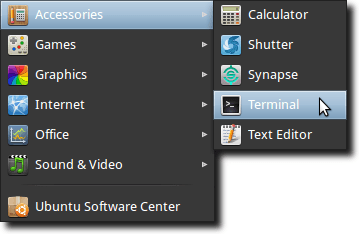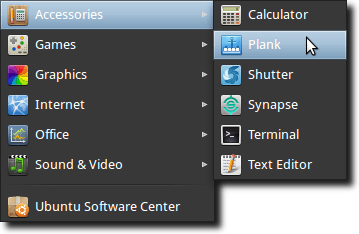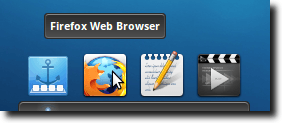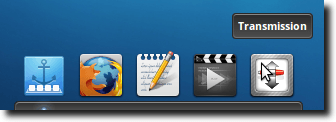There are a lot of different ways to launch applications in Linux. You can use the menu system. You can use the Run Dialog. You can open a Terminal and type in the name of the program. You can open the /usr/bin/ folder and double-click on the launcher inside. You can create Panel shortcuts.
For computer users coming from Mac OS X, the lack of a Dock can be, if not disappointing, then certainly a little bit of a change. Fortunately, Linux users have a lot of different Dock replacements, from Docky to Avant Window Navigator, but in this article, we’ll be discussing a brand new project, called Plank.
Plank, by its own description, is “Stupidly Simple,” and yet if all you’re looking for is a nice looking point-and-click method to launch your favorite applications, then it’s probably worth trying out. When installed and configured, this is what it looks like.

Unlike other Dock replacements, however, Plank does take some configuring. Here’s how to install it in Ubuntu and get it set up.
The first step is to open a Terminal, which will allow us to add the Plank PPA (Personal Package Archive) to our list of software sources.

Once the Terminal is open, type the following (provide your password if/when asked):
sudo apt-add-repository ppa:ricotz/docky
This will add the repository and import the public key.

Once this is finished, type the following to update your software lists:
sudo apt-get update
Finally, type the following to install Plank:
sudo apt-get install plank
When the installation is complete, you’ll find Plank in the Applications menu under Accessories.

Go ahead and launch it.

You’ll notice it looks a bit different from the first screenshot. This is because Plank only comes with those three launchers (Firefox, Gedit and Totem, plus the Plank icon on the far left). To add more, you’ll need to start launching a few programs.
This is where Plank’s relative “youth” comes into play. At the moment, you can’t simply drag and drop an application icon from the menu system, like you can in Docky, for instance, and have it appear in Plank.
When you start an application it will appear in Plank, but only until you quit the application. To keep it pinned, right-click the icon of a running application, and choose the Keep in Dock option.

Now close the application (in this instance Transmission), and you’ll see that it sticks, even when the application isn’t running.

At this point, you’ve pretty much seen what Plank can do. It doesn’t have applets or system load monitors, and you can’t view the album art of your currently playing music. But then again, to install Plank you’ll only need to download 233 kB of packages (at most) and Plank, once installed, only takes up 1,032 kB of hard drive space. When running, Plank uses effectively no CPU cycles and less than 1 percent of available memory on a laptop with 2 GB of RAM.
At the moment, Plank has no configuration interface, except by editing a text file by hand. The text file is at this location:
/home/ericcflem/.config/plank/settings
Note: change “ericcflem” in all examples to your own username
With this text file, you can control icon size and whether Plank should never hide, autohide or intellihide (only hide when a window wants to cover it). But that’s it. And if you want to rearrange the icons in Plank, you’ll need to do so, again by editing their text files, which can be found at this location:
/home/ericcflem/.config/plank/launchers
Each file has a four digit number (1001, 1002, 1003, etc.), that you can change. The icons are arranged, low to high, left to right.
As you can see, Plank at the moment isn’t exactly feature “rich” but return to its motto: Stupidly Simple. It’s not stupid, however, but very useful, especially to those with lower power computers. It’s fast, light on system resources, looks nice, and for launching programs, simply gets the job done.
For computer users coming from Mac OS X, the lack of a Dock can be, if not disappointing, then certainly a little bit of a change. Fortunately, Linux users have a lot of different Dock replacements, from Docky to Avant Window Navigator, but in this article, we’ll be discussing a brand new project, called Plank.
Plank, by its own description, is “Stupidly Simple,” and yet if all you’re looking for is a nice looking point-and-click method to launch your favorite applications, then it’s probably worth trying out. When installed and configured, this is what it looks like.

Unlike other Dock replacements, however, Plank does take some configuring. Here’s how to install it in Ubuntu and get it set up.
The first step is to open a Terminal, which will allow us to add the Plank PPA (Personal Package Archive) to our list of software sources.

Once the Terminal is open, type the following (provide your password if/when asked):
sudo apt-add-repository ppa:ricotz/docky
This will add the repository and import the public key.

Once this is finished, type the following to update your software lists:
sudo apt-get update
Finally, type the following to install Plank:
sudo apt-get install plank
When the installation is complete, you’ll find Plank in the Applications menu under Accessories.

Go ahead and launch it.

You’ll notice it looks a bit different from the first screenshot. This is because Plank only comes with those three launchers (Firefox, Gedit and Totem, plus the Plank icon on the far left). To add more, you’ll need to start launching a few programs.
This is where Plank’s relative “youth” comes into play. At the moment, you can’t simply drag and drop an application icon from the menu system, like you can in Docky, for instance, and have it appear in Plank.
When you start an application it will appear in Plank, but only until you quit the application. To keep it pinned, right-click the icon of a running application, and choose the Keep in Dock option.

Now close the application (in this instance Transmission), and you’ll see that it sticks, even when the application isn’t running.

At this point, you’ve pretty much seen what Plank can do. It doesn’t have applets or system load monitors, and you can’t view the album art of your currently playing music. But then again, to install Plank you’ll only need to download 233 kB of packages (at most) and Plank, once installed, only takes up 1,032 kB of hard drive space. When running, Plank uses effectively no CPU cycles and less than 1 percent of available memory on a laptop with 2 GB of RAM.
At the moment, Plank has no configuration interface, except by editing a text file by hand. The text file is at this location:
/home/ericcflem/.config/plank/settings
Note: change “ericcflem” in all examples to your own username
With this text file, you can control icon size and whether Plank should never hide, autohide or intellihide (only hide when a window wants to cover it). But that’s it. And if you want to rearrange the icons in Plank, you’ll need to do so, again by editing their text files, which can be found at this location:
/home/ericcflem/.config/plank/launchers
Each file has a four digit number (1001, 1002, 1003, etc.), that you can change. The icons are arranged, low to high, left to right.
As you can see, Plank at the moment isn’t exactly feature “rich” but return to its motto: Stupidly Simple. It’s not stupid, however, but very useful, especially to those with lower power computers. It’s fast, light on system resources, looks nice, and for launching programs, simply gets the job done.


No comments:
Post a Comment